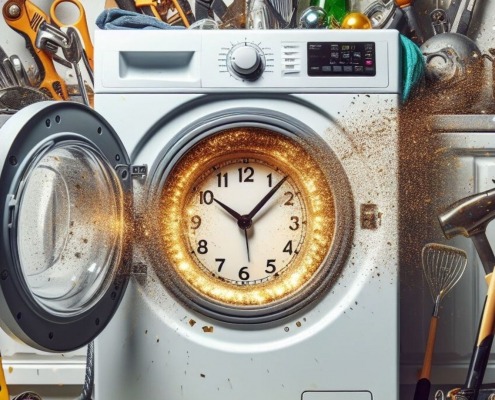Ice Buildup in Refrigerator Compartment: Top 7 Reasons and Fixes for Kenmore, Whirlpool, Frigidaire, GE, and Other Brands (With Video!)
APP Expert / Friday July 16, 2021
Is your refrigerator turning into a glacier with unexpected ice buildup? This common issue can be a headache, but don’t worry—our easy step-by-step guide will walk you through troubleshooting the culprit behind the frost. And just below, check out our video tutorial to see exactly how to tackle this freezing dilemma yourself, saving you time and money!
If your refrigerator compartment is having a problem with ice buildup, it’s likely that a component in the unit isn’t working correctly. Before troubleshooting the issue, it’s essential to make sure the work area is safe. This is done by turning off the circuit breaker or unplugging the refrigerator from the wall. You should also turn off the water controls for the fridge under the sink. Once your refrigerator is safe to work with, continue with this easy guide to determine which parts in the unit may be causing the problem and save money fixing it yourself.
When you have identified the part needed for your refrigerator, search below using your specific fridge model number to identify the exact part needed:
1. Defrost Thermostat
The first component to troubleshoot if the refrigerator has an ice buildup is the defrost thermostat. This is a safety component that turns the defrost cycle off when the refrigerator gets too warm. When the temperature is too high, it will turn the power off to the heater so things in the fridge don’t get too warm. Most of the time, there will be a temperature rating for the defrost thermostat that lets you know when the defrost cycle will turn on and off.
Often the defrost thermostat can be found on the evaporator behind the back wall of the refrigerator. If there is ice building up in the refrigerator, this can be caused by a defrost thermostat that has gone bad. In some cases, when it goes bad, the evaporator will be covered in ice. An excellent first step is to test the thermostat to see whether it is colder than the reset temperature. It should be colder or something is likely wrong.
Take a multimeter and put it on continuity settings before testing it by putting the two probes together. If it’s working, the probes should be used on the terminals or bare wires of the defrost thermostat. Continuity should be shown when the part is cold. If it is not, this component will need to be replaced.
2. Defrost Timer
If the defrost thermometer is working well, the problem could be the result of a bad defrost timer. It controls the defrost cycle of the refrigerator and can lead to a refrigerator with ice buildup if it isn’t working correctly. The defrost timer consists of contacts, a motor, and gear. It takes the refrigerator into cooling and defrost cycles so that ice can’t build up on the evaporator. Each timer is set to cool for a certain length of time and then defrost for a shorter amount of time.
Older refrigerators may have the defrost timer located behind the kick panel at the bottom of the fridge. Most other refrigerators will be found in the control panel area. If the defrost timer isn’t working the way it is supposed to be, ice can start to buildup in the refrigerator. The evaporator can also become covered in ice and make it harder for cold air to circulate in the refrigerator.
Testing whether the defrost timer is working can be done in two different ways. The first involves making a mark on the timer shaft, waiting for some time, and then coming back to see if the mark has moved. If it’s in a new place, the timer is working as it should be. If it’s not, the part will need to be replaced as the motor or gears have failed.
The other way to test this is by manually shifting the timer shaft using a screwdriver. Once it reaches defrost mode, the heater should make a sound as it comes on. This will require the refrigerator to be turned on. Find the heater behind the back wall of the refrigerator and then check it for heat after a few minutes. If there is none, the defrost timer will need to be replaced.
3. Defrost Heater
If everything looks good so far, the next component to check is the defrost heater when your refrigerator has ice buildup. This part is responsible for melting ice when it begins to build up on the evaporator. There are a wide variety of styles of defrost heaters but all of them do the same job of melting ice to keep the refrigerator cooling the appropriate amount.
Most of the time, the defrost heater will be located behind the freezer wall at the bottom or side of the evaporator. When this part fails, it can lead to a refrigerator that is too cold, which can cause ice. It also can lead to air that doesn’t circulate correctly so it needs to go through a continuity test. A multimeter set to continuity should have its probes placed together to see if it works right. Then use the probes on the wires and see if there is continuity. If there isn’t, the part will need to be replaced.
4. Ice Dispenser Chute Door
The ice dispenser chute door is the next place to look when frost is building up in the refrigerator. It is the part that allows ice to come out of the dispenser and can be found in a variety of designs, depending on the manufacturer and model of the fridge. This component opens up to let out ice when the dispenser arm is pressed and then closes and seals when it isn’t being pressed.
The door will be found in the dispenser area and typically sits behind the control panel. If the seal isn’t working or the door is damaged, cold and warm air can mix and cause frost to build up on the dispenser area. To get access to the chute door, use a small screwdriver or a putty knife to remove the frame from the control panel. After you get to the door, inspect it for any damage and replace it if there is a problem.
5. Defrost Temperature Sensor
If everything seems to be working well so far, the next thing to consider is the defrost temperature sensor. It is tasked with giving the temperature near the evaporator to the control board. The sensors are made up of white plastic and look like bulbs. They can indicate what the temperature is when the defrost cycle is happening. Defrost temperature sensors also turn off the power to the heater if the refrigerator is overly warm.
While there are several temperature sensors in different areas of the refrigerator, the defrost sensor is commonly located behind the back wall in the freezer area by the evaporator. If this part isn’t working, it can cause it to stop defrosting, which will make the fridge cold enough that frost can form. This part will need to be tested after removing it from the unit.
Like the defrost thermostat we looked at earlier, this sensor will have wires that connect to a nearby area. If these wires can be unplugged, they should be, but if not, they can be cut out of the refrigerator. Once you have the bare wires or the wiring harness disconnected, it’s time to test the ambient air temperature. You can find the proper temperature and corresponding ohms in the appliance’s user manual.
Use your multimeter set to ohms to read the defrost temperature sensor. The probes can be placed on the wiring harness pins or the bare wires to get the ohms. Next, make sure the numbers are similar to the ones in the user manual. If there is no reading or it’s off by a significant amount, a replacement is needed for the defrost temperature sensor.
6. Freezer Drain
The freezer drain is the component where the water drains when the refrigerator is in the defrost cycle. Typically, the freezer drain will be found in the back bottom of the freezer behind the back panel. If this component is clogged or frozen up, it will no longer be able to drain water. This means that water will leak out and reach the bottom of the freezer compartment, where it will turn into a large chunk of ice.
On a side by side refrigerator, if the drain is bad enough, the water can leak out onto the floor. If the freezer is on top of the refrigerator, the water can make its way into the refrigerator and lead to a buildup of frost. Find the drain and visually inspect it for any food or ice that could be clogging it up. If there’s anything there, it needs to be removed. If it’s ice, hot water will need to be poured in the drain or the refrigerator will have to be left unplugged to remove it. The drain tube should also be inspected if your refrigerator has one. Make sure between the evaporator pan and the cabinet there are no clogs causing problems. After any clogs are removed, the parts can be replaced on the fridge.
7. Door Gaskets
If none of the parts mentioned above need to be replaced, the door gaskets may be causing ice to build up in the refrigerator. This is a part used to seal the refrigerator doors and will usually have one flat and magnetic side while the other side has a rib so it mounts properly to the refrigerator door. If the door is closed, the gasket will seal to keep cold air from leaving and warm air from coming in.
The door gaskets mount to the door along the outer edge and your refrigerator might run too long or not long enough if they are deformed or dirty. If this is the case, it can make the compressor run too long or not long enough, which will affect the temperature of the refrigerator. This can lead to ice or a refrigerator that is too warm.
The first step is to inspect the door gaskets before cleaning them off. Most issues with the door gaskets will be on the hinge side and a hairdryer can often heat them up enough to reform them so they work the way they should. In some cases, the magnet in the gaskets can also fail. If the magnet isn’t working or the deformities can’t be repaired, the door gaskets will need to be replaced.
Where To Find Us
If you need any replacement parts for your appliances, you can enter your model number at AppliancePartsPros.com to locate and order them quickly. Most orders arrive in just two business days, and we have tons of great information in our repair help section and YouTube videos to help you troubleshoot.
Stay connected with the latest DIY tips, tutorial videos, and repair guides by following us on Facebook, Instagram, and Twitter. We love hearing about your repair stories and successes. If you need more help or want personalized guidance, feel free to reach out. We’re ready to help you take on your next project with confidence!
Hi! I’m Matt H., and I’m thrilled to be your guide through the world of appliance repair with over 25 years of invaluable experience in the industry.
From the early days of my career, I have been deeply passionate about appliances and their inner workings. Over the years, I’ve seen it all – from vintage models to the latest cutting-edge technology – and I’ve dedicated myself to mastering the art of repair. With a toolbox in one hand and a wealth of knowledge in the other, I’ve tackled every challenge that has come my way, learning and growing with each repair.
Join me as we dive into the intricacies of appliance repair. From step-by-step repair guides to explanations of common problems and their solutions, I’ll be here to simplify the repair process and empower you with the knowledge you need to keep your appliances running smoothly.
Feel free to explore our blog, ask questions, and leave comments – this platform is a space for learning, sharing, and growing together. Let’s work together to ensure that your appliances continue to serve you for years to come.
Thank you for joining me on this journey, and I look forward to being your go-to resource for all things related to appliance repair!





